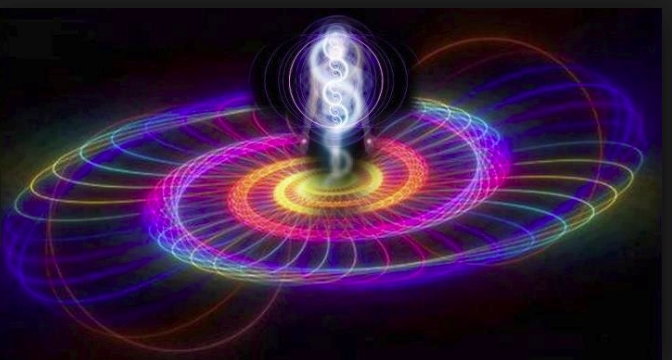L’entanglement quantico tiene insieme il DNA

Quantum Entanglement Holds DNA TogetherThere was a time, not so long ago, when biologists swore black and blue that quantum mechanics could play no role in the hot, wet systems of life. Since then, the discipline of quantum biology has emerged as one of the most exciting new fields in science. It’s beginning to look as if quantum effects are crucial in a number of biological processes, such as photosynthesis and avian navigation. Now a group of physicists say that the weird laws of quantum mechanics may be more important for life than biologists could ever have imagined. Their new idea is that DNA is held together by quantum entanglement. That’s worth picking apart in more detail. Entanglement is the weird quantum process in which a single wavefunction describes two separate objects. When this happens, these objects effectively share the same existence, no matter how far apart they might be. The question that Elisabeth Rieper at the National University of Singapore and a couple of buddies have asked is what role might entanglement play in DNA. To find out, they’ve constructed a simplified theoretical model of DNA in which each nucleotide consists of a cloud of electrons around a central positive nucleus. This negative cloud can move relative to the nucleus, creating a dipole. And the movement of the cloud back and forth is a harmonic oscillator. When the nucleotides bond to form a base, these clouds must oscillate in opposite directions to ensure the stability of the structure. Rieper and co ask what happens to these oscillations, or phonons as physicists call them, when the base pairs are stacked in a double helix. Phonons are quantum objects, meaning they can exist in a superposition of states and become entangled, just like other quantum objects. To start with, Rieper and co imagine the helix without any effect from outside heat. “Clearly the chain of coupled harmonic oscillators is entangled at zero temperature,” they say. They then go on to show that the entanglement can also exist at room temperature. That’s possible because phonons have a wavelength which is similar in size to a DNA helix and this allows standing waves to form, a phenomenon known as phonon trapping. When this happens, the phonons cannot easily escape. A similar kind of phonon trapping is known to cause problems in silicon structures of the same size. That would be of little significance if it had no overall effect on the helix. But the model developed by Rieper and co suggests that the effect is profound. Although each nucleotide in a base pair is oscillating in opposite directions, this occurs as a superposition of states, so that the overall movement of the helix is zero. In a purely classical model, however, this cannot happen, in which case the helix would vibrate and shake itself apart. So in this sense, these quantum effects are responsible for holding DNA together. The question of course is how to prove this. They say that one line of evidence is that a purely classical analysis of the energy required to hold DNA together does not add up. However, their quantum model plugs the gap. That’s interesting but they’ll need to come up with something experimentally convincing to persuade biologists of these ideas. One tantalising suggestion at the end of their paper is that the entanglement may have an influence on the way that information is read off a strand of DNA and that it may be possible to exploit this experimentally. Just how, they don’t say. Speculative but potentially explosive work. |
L’entanglement quantico tiene insieme il DNAC’è stato un tempo, non molto tempo fa, in cui i biologi hanno giurato il nero e il blu che la meccanica quantistica non potrebbe giocare alcun ruolo nei sistemi di vita caldi e umidi. Da allora, la disciplina della biologia quantistica è emersa come uno dei più eccitanti nuovi campi della scienza. Sta cominciando a sembrare che gli effetti quantistici siano cruciali in una serie di processi biologici, come la fotosintesi e la navigazione aviaria, che abbiamo visto qui e qui. Ora un gruppo di fisici afferma che le strane leggi della meccanica quantistica potrebbero essere più importanti per la vita di quanto i biologi avrebbero mai potuto immaginare. La loro nuova idea è che il DNA sia tenuto insieme dall’entanglement quantistico. Vale la pena scegliere in modo più dettagliato. Entanglement è lo strano processo quantico in cui una singola funzione d’onda descrive due oggetti separati. Quando ciò accade, questi oggetti condividono effettivamente la stessa esistenza, non importa quanto lontani possano essere. La domanda che Elisabeth Rieper alla National University di Singapore e un paio di amici hanno chiesto è quale ruolo possa avere il coinvolgimento di entanglement nel DNA. Per scoprirlo, hanno costruito un modello teorico semplificato di DNA in cui ogni nucleotide consiste in una nuvola di elettroni attorno a un nucleo centrale positivo. Questa nuvola negativa può muoversi rispetto al nucleo, creando un dipolo. E il movimento della nuvola avanti e indietro è un oscillatore armonico. Quando i nucleotidi si legano per formare una base, queste nuvole devono oscillare in direzioni opposte per garantire la stabilità della struttura. Rieper e co chiedono che cosa succede a queste oscillazioni, o fononi come li chiamano i fisici, quando le coppie di basi sono accatastate in una doppia elica. I fononi sono oggetti quantici, nel senso che possono esistere in una sovrapposizione di stati e diventare invischiati, proprio come gli altri oggetti quantici. Per cominciare, Rieper e co immaginare l’elica senza alcun effetto dal calore esterno. “Chiaramente la catena di oscillatori armonici accoppiati è impigliata a temperatura zero”, dicono. Poi continuano a dimostrare che l’entanglement può anche esistere a temperatura ambiente. Ciò è possibile perché i fononi hanno una lunghezza d’onda che è simile per dimensioni a un’elica del DNA e questo consente alle onde stazionarie di formarsi, un fenomeno noto come intrappolamento di fononi. Quando ciò accade, i fononi non possono facilmente fuggire. Un tipo simile di trapping phonon è noto per causare problemi nelle strutture di silicio della stessa dimensione. Ciò sarebbe di scarsa importanza se non avesse alcun effetto complessivo sull’elica. Ma il modello sviluppato da Rieper e Co suggerisce che l’effetto è profondo. Sebbene ciascun nucleotide in una coppia di basi oscilli in direzioni opposte, ciò avviene come una sovrapposizione di stati, in modo che il movimento complessivo dell’elica sia zero. In un modello puramente classico, tuttavia, questo non può accadere, nel qual caso l’elica vibrerebbe e si scuoterebbe. Quindi in questo senso, questi effetti quantistici sono responsabili di tenere insieme il DNA. La domanda ovviamente è come dimostrarlo. Dicono che una linea di prova è che un’analisi puramente classica dell’energia richiesta per tenere insieme il DNA non si somma. Tuttavia, il loro modello quantico colma il divario. È interessante, ma dovranno trovare qualcosa di sperimentalmente convincente per convincere i biologi di queste idee. Un allettante suggerimento alla fine del loro articolo è che l’entanglement può avere un’influenza sul modo in cui l’informazione viene letta da un filamento di DNA e che potrebbe essere possibile sfruttarla sperimentalmente. Proprio come, non dicono. Lavoro speculativo ma potenzialmente esplosivo. |

